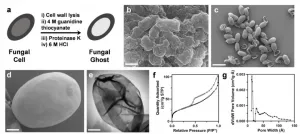Blind trust in social media cements conspiracy beliefs
2021-03-05
(Press-News.org) PULLMAN, Wash. - The ability to identify misinformation only benefits people who have some skepticism toward social media, according to a new study from Washington State University.
Researchers found that people with a strong trust in information found on social media sites were more likely to believe conspiracies, which falsely explain significant events as part of a secret evil plot, even if they could identify other types of misinformation. The study, published in the journal Public Understanding of Science on March 5, showed this held true for beliefs in older conspiracy theories as well as newer ones around COVID-19.
"There was some good and bad news in this study," said Porismita Borah, an associate professor in WSU's Edward R. Murrow College of Communication and a corresponding author on the study. "The good news is that you are less susceptible to conspiracy theories if you have some media literacy skills, one of which is being able to identify misinformation. But if you blindly trust the information you find on social media, those skills might not be able to help."
Identifying misinformation is just one part of media literacy, Borah pointed out, and people may need a deeper education around social media to avoid falling for conspiracy theories.
For the study, the researchers surveyed 760 people recruited via Amazon's Mechanical Turk crowdsourcing website. The participants were roughly split between male and female as well as Democrat and Republican. The majority, 63.1%, used Facebook and 47.3% used Twitter daily. They answered a range of questions related to the level of their social media news use and trust as well as ability to identify misinformation.
The participants were also asked to rate the truth of several COVID-19 conspiracy theories, such as the belief that the virus was a weapon of biological warfare developed by foreign countries. They also were presented with older conspiracies to rate, such as that the moon landing was a hoax and that Princess Diana was killed by a British intelligence agency.
The researchers found that a greater ability to identify misinformation lowered beliefs in all conspiracy theories--except for those who had high levels of trust in social media information. This is particularly problematic because other research has shown that once a conspiracy belief takes hold, it is very hard to convince the believer that it is false.
"The patterns around trust is one of the most important findings from our study," said Borah. "We need to go deeper into what this trust means."
Borah and her co-authors, recent WSU Ph.D. Xizhu Xiao and current doctoral student Yan Su, suggest that political ideology may play a role in this trust--that people want to believe the words of political figures they admire, whether what they say is actually true or not. Borah said more research is needed to understand why conspiracy theories appeal to people and how best to combat them as there can be serious consequences.
"There are different levels of danger with these theories, but one of the prominent conspiracy beliefs about COVID-19 is that it isn't true, that the virus is a hoax and that can be really dangerous: you're putting yourself, your family members and your community at risk," said Borah.
The researchers advocate for making media literacy part of the educational system and starting it well before college. They argue that such education should include a better understanding of how information can be manipulated as well as social media environments, news production and dissemination.
"There's a long list of tasks to do to keep ourselves well informed," Borah said. "I think there is hope with media literacy and a better understanding of the information environment, but it is a complicated process."
INFORMATION:
ELSE PRESS RELEASES FROM THIS DATE:
2021-03-05
Boulder, Colo., USA: In its large caldera, Newberry volcano (Oregon, USA) has two small volcanic lakes, one fed by volcanic geothermal fluids (Paulina Lake) and one by gases (East Lake). These popular fishing grounds are small windows into a large underlying reservoir of hydrothermal fluids, releasing carbon dioxide (CO2) and hydrogen sulfide (H2S) with minor mercury (Hg) and methane into East Lake.
What happens to all that CO2 after it enters the bottom waters of the lake, and how do these volcanic gases influence the lake ecosystem? Some lakes fed by volcanic CO2 have seen catastrophic ...
2021-03-05
Research over the last decade has shown that loneliness is an important determinant of health. It is associated with considerable physical and mental health risks and increased mortality. Previous studies have also shown that wisdom could serve as a protective factor against loneliness. This inverse relationship between loneliness and wisdom may be based in different brain processes.
In a study published in the March 5, 2021 online edition of Cerebral Cortex, researchers at University of California San Diego School of Medicine found that specific regions of the brain respond to emotional stimuli related to loneliness and wisdom in opposing ways.
"We were interested ...
2021-03-05
DURHAM, N.C. -- When you think about what separates humans from chimpanzees and other apes, you might think of our big brains, or the fact that we get around on two legs rather than four. But we have another distinguishing feature: water efficiency.
That's the take-home of a new study that, for the first time, measures precisely how much water humans lose and replace each day compared with our closest living animal relatives.
Our bodies are constantly losing water: when we sweat, go to the bathroom, even when we breathe. That water needs to be replenished to keep blood volume and other body fluids within normal ranges.
And yet, research published March 5 in the journal Current Biology shows that the human body uses 30% to 50% less water per ...
2021-03-05
The idea of creating selectively porous materials has captured the attention of chemists for decades. Now, new research from Northwestern University shows that fungi may have been doing exactly this for millions of years.
When Nathan Gianneschi's lab set out to synthesize melanin that would mimic that which was formed by certain fungi known to inhabit unusual, hostile environments including spaceships, dishwashers and even Chernobyl, they did not initially expect the materials would prove highly porous-- a property that enables the material to store and capture molecules.
Melanin has been found across living organisms, on our skin and the backs of ...
2021-03-05
Using genetic engineering, researchers at UT Southwestern and Indiana University have reprogrammed scar-forming cells in mouse spinal cords to create new nerve cells, spurring recovery after spinal cord injury. The findings, published online today in Cell Stem Cell, could offer hope for the hundreds of thousands of people worldwide who suffer a spinal cord injury each year.
Cells in some body tissues proliferate after injury, replacing dead or damaged cells as part of healing. However, explains study leader END ...
2021-03-05
What The Study Did: The objectives of this study were to examine the characteristics and outcomes among adults hospitalized with COVID-19 at U.S. medical centers and analyze changes in mortality over the initial six months of the pandemic.
Authors: Ninh T. Nguyen, M.D., of the University of California, Irvine Medical Center, in Orange, is the corresponding author.
To access the embargoed study: Visit our For The Media website at this link https://media.jamanetwork.com/
(doi:10.1001/jamanetworkopen.2021.0417)
Editor's Note: The article includes ...
2021-03-05
What The Study Did: Survey data were used to estimate changes in racial/ethnic disparities in rates of autism spectrum disorder among U.S. children and adolescents from 2014 through 2019.
Authors: Z. Kevin Lu, Ph.D., of the University of South Carolina in Columbia, is the corresponding author.
To access the embargoed study: Visit our For The Media website at this link https://media.jamanetwork.com/
(doi:10.1001/jamanetworkopen.2021.0771)
Editor's Note: Please see the article for additional information, including other authors, author contributions and affiliations, conflict of interest and financial disclosures, and funding and support.
INFORMATION:
Media advisory: The full study is linked to this news release.
Embed ...
2021-03-05
What The Study Did: Researchers examined the association of increased anti-immigrant rhetoric during the 2016 presidential campaign with changes in the use of health care services among undocumented patients.
Authors: Joseph Nwadiuko, M.D., M.P.H., M.S.H.P., of the University of Pennsylvania Perelman School of Medicine in Philadelphia, is the corresponding author.
To access the embargoed study: Visit our For The Media website at this link https://media.jamanetwork.com/
(doi:10.1001/jamanetworkopen.2021.0763)
Editor's Note: Editor's Note: The article includes conflicts of interest and funding/support disclosures. Please see the article ...
2021-03-05
What The Study Did: In this study, many children and adolescents hospitalized for COVID-19 or multisystem inflammatory syndrome in children had neurologic involvement, mostly transient symptoms. A range of life-threatening and fatal neurologic conditions associated with COVID-19 infrequently occurred. Effects on long-term neurodevelopmental outcomes are unknown.
Authors: Adrienne G. Randolph, M.D., of Boston Children's Hospital, is the corresponding author.
To access the embargoed study: Visit our For The Media website at this link https://media.jamanetwork.com/
(doi:10.1001/jamaneurol.2021.0504)
Editor's Note: The article includes conflict of interest ...
2021-03-05
DNA sequencing of bacteria found in pigs and humans in rural eastern North Carolina, an area with concentrated industrial-scale pig-farming, suggests that multidrug-resistant Staphylococcus aureus strains are spreading between pigs, farmworkers, their families and community residents, and represents an emerging public health threat, according to a study led by researchers at the Johns Hopkins Bloomberg School of Public Health.
S. aureus is commonly found in soil and water, as well as on the skin and in the upper respiratory tract in pigs, other animals, and people. It can cause medical problems from minor skin infections to serious surgical wound infections, pneumonia, and the often-lethal blood-infection condition known as sepsis. The findings provide evidence that multidrug-resistant ...
LAST 30 PRESS RELEASES:
[Press-News.org] Blind trust in social media cements conspiracy beliefs


